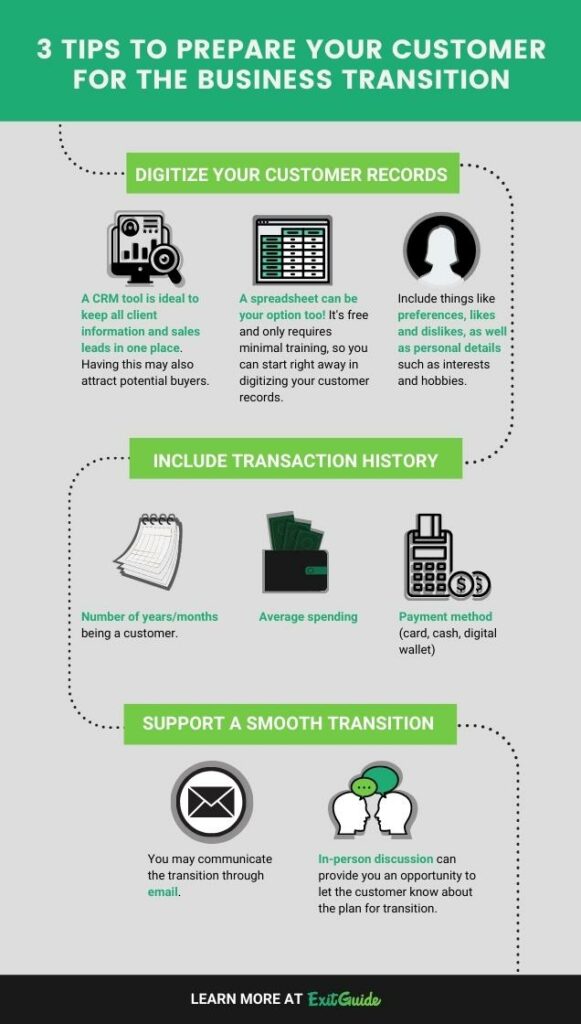Customers are the lifeblood of your business, most small business owners establish relationships with their customers that are vital to repeat business. When transitioning out of a business, how you hand over these relationships to a new owner is one of the most important factors in a successful business exit.
If you are thinking about an exit strategy, you can take some steps to make sure you take care of customers and provide a new owner with confidence that these customers will continue to engage with your business. Here are three things you can do to ensure a smooth transition.

Digitize Your Customer Records
Depending on the type of business you run, you may have a few dozen to hundreds (maybe thousands) of customers. If you have run your business for five years or more, some of these customers have transacted recently whereas others may go back a few years while you may have a list of potential customers as well.
If your customer information is in your head or on paper, getting this information into a digital format should be one of the first steps you take. Don’t wait. Even starting with an online spreadsheet will work and make sure at least one additional person you trust has access. You may even have someone else in your business help complete this so having a shared version of the file allows for collaboration.
The goal is to have a record for all your customers and leads so a new owner can communicate with them from the start and develop an understanding of their needs.
Moving to something more robust such as a Customer Relationship Management tool can be useful to manage your business today and will also make the business appealing to potential buyers as they will inherit a customer base they can immediately engage.
When creating a customer record, in a spreadsheet or CRM tool, add more than just basic contact information. Include notes about things such as preferences, likes and dislikes, and maybe even personal details such as interests or hobbies that make it easier for a new owner to bond with the customer. If information is in different sources such as email and point of sales systems, consolidating it may sound like a headache but will prove to be a valuable use of time.
Include Transaction History
In addition to the customer contact information and other details, having a history of how much they spend, how often they transact, and how they like to pay is important and valuable to ensure a smooth transition. Any information such as credit card information must be stored securely and separated from a customer record. However, a history of the amounts they paid and what they purchased provides an incredibly insightful view of the overall customer base and may help a new owner prioritize certain customers when reaching out shortly after taking over the business. Some of the most helpful information to include:
- How long have they been a customer?
- How much do they spend & how often?
- How do they like to pay (credit card, check, ACH)?
- Are there special payment terms for a particular customer?
- Do they pay on time or need reminders?
This information also helps a new owner understand if revenue (sales) is concentrated with a small number of customers and there is a need to diversify the source of revenue over time.
Support A Smooth Transition
If you are a bit worried about someone else taking good care of your customers, you are not alone. As a business owner, you worked hard to build trust and a reputation for great work and of course, you want to ensure the same level of care and attention is given. In fact, your customers may share the same concern when learning you are transitioning out of the business. One of the best things you can do for your customers and your business is to be proactive with communication and support.
When developing a transition plan, you may want to offer to the new owner to proactively communicate to customers about your transition with an email. In some cases, you may decide to meet some customers one on one and listen to any concerns and explain your decision and how you plan to help ensure a smooth transition. It may be worthwhile to make yourself available during a transition period – a new owner will often be more than happy to have you stick around for a bit to help with internal issues and also to make sure your best customers feel comfortable with the transition.
Exiting a business can have a number of moving parts, taking care of your customers is important to you, to your customers, and a new owner. Take the time to create a digital record that is more than just a contact list and proactively communicate the transition and that you are available to help things go smoothly. By taking these steps, you can exit your business knowing your customers will be happy and stay with the business.
